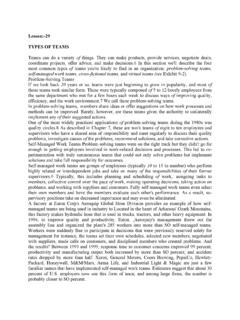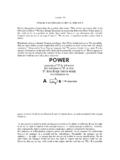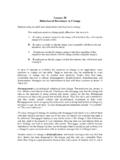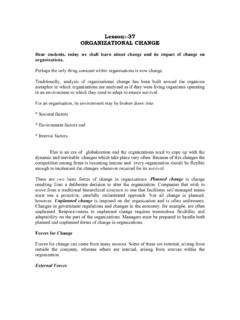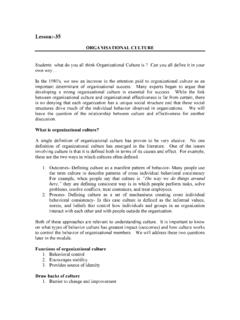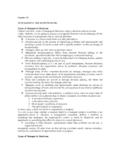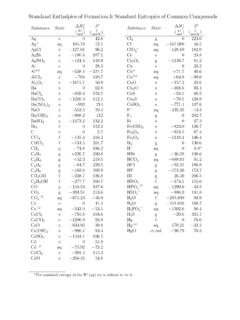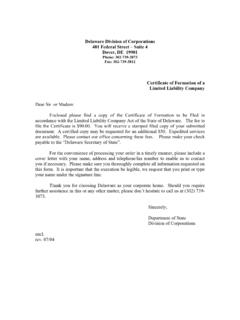Transcription of STAGES OF GROUP DEVELOPMENT Formation of Groups
1 Lesson:-25. STAGES OF GROUP DEVELOPMENT . Formation of Groups Two models of GROUP DEVELOPMENT have been offered by the researchers in the field of social sciences to explain how Groups are formed. These are: a) Five- stage Model and b) Punctuated Equilibrium Model. According to the Five- stage Model of GROUP DEVELOPMENT , Groups go through five distinct STAGES during the process of its DEVELOPMENT . These are as follows: Five- stage Model Forming is the initial stage of GROUP DEVELOPMENT when the GROUP members first come in contact with others and get acquainted with each other. This stage is characterized predominantly by a feeling of uncertainty among the GROUP members as they now try to establish ground rules and pattern of relationship among themselves. Storming is the next stage that is characterized by a high degree of conflict among the members. Members often show hostility towards each other and resist the leader's control.
2 If these conflicts are not adequately resolved, the GROUP may even be disbanded. But, usually the GROUP eventually comes in terms with each other and accepts the leadership role at the end of this stage . Norming is the third stage of the GROUP DEVELOPMENT process during which the GROUP members become closer to each other and the GROUP starts functioning as a cohesive unit. The GROUP members now identify themselves with the GROUP and share responsibility for achieving the desired level of performance of the GROUP . Norming stage is complete when the GROUP members can set a common target and agree on the way of achieving this. Performing is the fourth stage when the GROUP is finally ready to start working. As the GROUP is now fully formed after resolving their internal conflicts of acceptance and sharing responsibility, they can now devote energy to achieve its objectives.
3 Adjourning is the final stage when the GROUP , after achieving the objectives for which it was created, starts to gradually dissolve itself. Many interpreters of the five- stage model have assumed that a GROUP becomes more effective as it progresses through the first four STAGES . While this assumption may be generally true, what makes a GROUP effective is more complex than this model acknowledges. Under some conditions, high levels of conflict are conducive to high GROUP performance. So we might expect to find situations in which Groups in stage II outperform those in STAGES III or IV. Similarly, Groups do not always proceed clearly from one stage to the next. Sometimes, in fact, several STAGES go on simultaneously, as when Groups are storming and performing at the same time. Groups even occasionally regress to previous STAGES . Therefore, even the strongest proponents of this model do not assume that all Groups follow its five- stage process precisely or that stage IV is always the most preferable.
4 Another problem with the five- stage model, in terms of understanding work- related behavior, is that it ignores organizational For instance, a study of a cockpit crew in an airliner found that, within 10 minutes, three strangers as- signed to fly together for the first time had become a high-performing GROUP . What allowed for this speedy GROUP DEVELOPMENT was the strong organizational context surrounding th~ tasks of the cockpit crew. This context provided the rules, task definitions, information, and resources needed for the GROUP to per- form. They didn't need to develop plans, assign roles, determine and allocate re- sources, resolve conflicts, and set norms the way the five- stage model predicts. An Alternative Model: For Temporary Groups With Deadlines Temporary Groups with deadlines don't seem to follow the previous model. Studies indicate that they have their own unique sequencing of actions (or inaction): (1) Their first meeting sets the GROUP 's direction; (2) this first phase of GROUP activity is one of inertia; (3) a transition takes place at the end of this first phase, which occurs exactly when the GROUP has used up half its allotted time; (4) a transition initiates major changes; (5) a second phase of inertia follows the transition.
5 And (6) the GROUP 's last meeting is characterized by markedly accelerated activity . This pattern is called the punctuated equilibrium model and is shown below. Figure: Punctuated equilibrium Model The first meeting sets the GROUP 's direction. A framework of behavioral pat- terns and assumptions through which the GROUP will approach its project emerges in this first meeting. These lasting patterns can appear as early as the first few seconds of the GROUP 's life. Once set, the GROUP 's direction becomes "written in stone" and is unlikely to be reexamined throughout the first half of the GROUP 's life. This is a period of inertia that is, the GROUP tends to stand still or become locked into a fixed course of action. Even if it gains new insights that challenge initial patterns and assumptions, the GROUP is incapable of acting on these new insights in Phase 1. One of the more interesting discoveries made in these studies was that each GROUP experienced its transition at the same point in its calendar-precisely halfway between its first meeting and its official deadline-despite the fact that some Groups spent as little as an hour on their project while others spent six months.
6 It was as if the Groups universally experienced a midlife crisis at this point. The midpoint appears to work like an alarm clock, heightening members' awareness that their time is limited and that they need to "get moving.". This transition ends Phase 1 and is characterized by a concentrated burst of changes in which old patterns are dropped and new perspectives are adopted. The transition sets a revised direction for Phase 2. Phase 2 is a new equilibrium or period of inertia. In this phase, the GROUP executes plans created during the transition period. The GROUP 's last meeting is characterized by a final burst of activity to finish its work. In summary, the punctuated-equilibrium model characterizes Groups as exhibiting long periods of inertia interspersed with brief revolutionary changes triggered primarily by their members'. awareness of time and deadlines.
7 Keep in mind, however, that this model doesn't apply to all Groups . It's essentially limited to temporary task Groups that are working under a time-constrained completion deadline.
